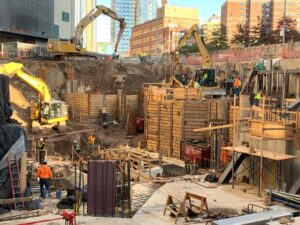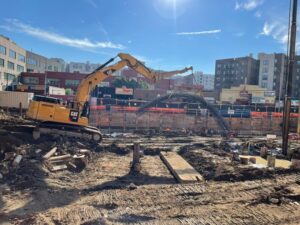

Rock anchors are a type of earth retention element used to provide support and stability for a structure or excavation and are typically socketed into suitable rock. Rock anchors are used to satisfy the uplift capacity of a structure, excavation support, and slope stabilization.
Tiebacks are a type of stabilization and support element used to transfer tension loads and provide support for excavation support, slope stabilization, and tie-down applications for structures. Tiebacks are particularly well-suited for use in challenging soil or rock conditions and can be used to help stabilize slopes and support excavations in challenging soil conditions.
Soldier piles and lagging are commonly used together to create a retaining wall and to support excavation. Soldier piles are installed in order to assume the load of the excavation or structure for projects with deep excavation needs. Lagging typically consists of wood that is placed between the soldier piles to create a retaining wall or support structure and provides additional stabilization during and after the excavation process. Soldier piles and lagging provide additional stability and reduce the risk of soil collapse or other instability which helps to ensure the safety of workers and the surrounding area.
Sheet piling is a technique that is used for earth retention and excavation support consisting of steel sheet sections with interlocking edges to retain soil and form a wall for permanent or temporary lateral earth support. Sheet piles are typically installed using vibratory hammers; however, in certain soil conditions, an impact hammer can be used to complete the installation. In situations where vibrations are a concern, such as when working near sensitive structures or equipment, the sheets can be hydraulically advanced into the ground. Sheet piling greatly reduces groundwater infiltration and provides effective earth retention and excavation support in a variety of soil and rock conditions.
Secant and tangent piles are a type of deep foundation that is used to support structures and retain soil in a variety of soil conditions.
Secant piles are piles that are constructed in such a way that they overlap with each other, creating a continuous wall with a series of interlocking piles that form a barrier to the flow of water. They are often used in construction projects where groundwater control is necessary, such as in the construction of retaining walls or underground structures.
Tangent piles, on the other hand, are piles that are constructed adjacent to each other, without overlapping. They are often used in the construction of retaining walls and other structures where a deep foundation is required, but water control is not a concern.
Both secant and tangent piles can be used to support and stabilize slopes, enable and support excavations, support bulkheads, and create barriers to groundwater flow. They are a versatile and effective solution for support of excavation and earthwork projects.
Soil nailing is a technique used to stabilize slopes, repair retaining walls, and provide earth retention for excavations. It involves the installation of grouted steel elements, known as “nails,” into the soil to provide tension-resisting support. Soil nailing can be used for both temporary and permanent support, depending on the specific needs of the project. This technique is often used to stabilize soil, repair retaining walls, and provide earth retention for excavations.